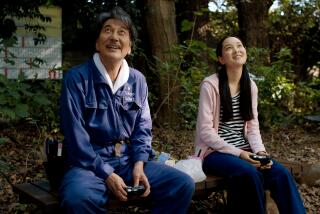FILM : Deep in the Art of ‘Paris, Texas’
- Share via
Wim Wenders’ “Paris, Texas” arrived in the States on a roll, having been hailed by European critics and winning the Golden Palm Award at the 1984 Cannes Film Festival. Everyone loved Sam Shepard’s eccentric, sun-baked script and Wenders’ vision of it.
But the momentum died quickly after its American release. Most critics here disliked it, sometimes with a passion. The movie (screening at Golden West College Friday night) sputtered at the box office, and Wenders and Shepard took major hits on their careers.
Explaining the popularity of “Paris, Texas” in Europe, and its lack of success in America, may have something to do with how overseas audiences perceive this country. In the film, a sort of slowly revving “road movie” following Travis (Harry Dean Stanton) as he pursues his past and the family he left behind, Wenders uses Shepard’s story (L.M. Kit Carson helped with the adaptation) to give what amounts to a European perspective on a sub-layer of American life.
It attracted Europeans because it confirms the view of the U.S. as symbolic of many things, including estrangement and idiosyncrasy. The movie was praised for much the same reasons David Lynch’s movies are praised--its quirkiness exemplifies what they believe is the colorful, stark and not always settled essence of our culture.
American critics, for the most part, found Wenders’ approach shallow and obsessive. Shepard took his usual shots for creating dramatic tension through sensationalistic but often nearsighted devices.
The film is not as telling as European reviewers saw it, but it’s more valid than one would derive from the dismissive stance taken by most of our critics. The plot is minimal--Travis, who deserted his family four years earlier, is taken to California by his brother soon after he’s found wandering in the desert. A few weeks later, he drives to Texas, searching for his wife, that’s about it--but there are valuable moments within this framework.
What it has to offer is an intriguing performance by Stanton, who methodically draws us into Travis’ despair, some striking desert cinematography by Robby Muller, an eerie slide guitar score by Ry Cooder and a few outstanding set pieces.
The long-awaited reunion between Travis and his missing wife (Nastassja Kinski, miscast with a weak Texas accent but looking wonderfully exotic) in a bizarre sex parlor in Houston is close to hypnotic. And the opening scenes, where we first meet Travis as a mute bum who could be crazy and his caring brother (Dean Stockwell), has a disturbing edge.
“Paris, Texas” is less compelling when it comes to the relationship between Travis and his 8-year-old son (Hunter Carson), who’s been staying with Travis’ brother. Besides the script’s obliqueness with these two, Shepard shows obvious unease in describing the ways of a boy.
The dialogue just doesn’t ring true. Wenders exacerbates this by throwing in a few cutesy, cliched moments (Hunter gleefully mimics his father’s antics as they walk home from school) that are meant to be endearing but come out disingenuous.
All this father and son stuff occupies much of the movie’s middle. Thankfully, the beginning and closing sections are more expressive.
What: Wim Wenders’ “Paris, Texas.”
When: Friday, April 5, at 7:30 p.m.
Where: The Forum II theater, Golden West College, 15744 Golden West St., Huntington Beach.
Whereabouts: Take the San Diego (405) Freeway to Golden West Street and head south. The college is just north of Edinger Avenue.
Wherewithal: $3 and $3.50.
Where to Call: (714) 891-3991.
More to Read
Only good movies
Get the Indie Focus newsletter, Mark Olsen's weekly guide to the world of cinema.
You may occasionally receive promotional content from the Los Angeles Times.










